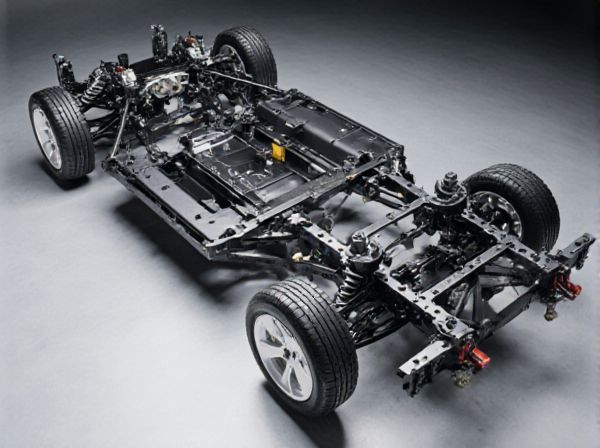
Photo illustration: Space Frame vs Backbone Chassis
Space frames offer superior rigidity and weight distribution by using a network of interconnected tubes, enhancing your vehicle's handling and safety. Backbone chassis feature a strong central spine for mounting components, providing simplicity and ease of maintenance but may lack the torsional stiffness of a space frame. Choosing between these chassis types depends on your priorities for performance, weight, and structural integrity.
Table of Comparison
| Feature | Space Frame Chassis | Backbone Chassis |
|---|---|---|
| Structure | Network of interconnected tubes forming a rigid frame | Central tubular spine supporting the car body |
| Weight | Lightweight due to optimized tube arrangement | Heavier from a solid central backbone |
| Strength | High torsional rigidity and crash resistance | Moderate rigidity, less resistant to torsion |
| Manufacturing Complexity | High complexity, requires precise welding | Simpler, easier to fabricate and assemble |
| Application | Sports cars, race vehicles requiring high performance | Utility vehicles, some sports cars with simpler design |
| Cost | More expensive due to complex fabrication | Lower cost from simpler construction |
Introduction to Vehicle Chassis Types
Space frame chassis feature a network of interconnected tubes, forming a lightweight yet rigid structure that enhances vehicle strength and safety. Backbone chassis consist of a central, strong tubular spine supporting the engine, transmission, and suspension, offering simplicity and ease of maintenance. Both chassis types serve as the fundamental framework of vehicles, impacting performance, weight distribution, and structural integrity.
What is a Space Frame Chassis?
A space frame chassis is a structural framework made from interconnected tubular steel or aluminum members designed to distribute loads evenly throughout the vehicle. This design enhances rigidity and reduces weight, improving handling and performance in automotive and motorsport applications. Unlike a backbone chassis that relies on a central spine for support, the space frame utilizes multiple triangulated sections to provide superior strength and torsional stiffness.
What is a Backbone Chassis?
A backbone chassis is a vehicle frame design featuring a central tubular structure that carries the load and houses drivetrain components, providing high torsional rigidity and strength. Unlike a space frame, which relies on a network of interconnected tubes forming multiple triangles to distribute stress evenly, the backbone chassis centralizes structural integrity along a single spine. This design simplifies manufacturing, reduces weight, and improves handling in sports cars and off-road vehicles by concentrating stiffness where it's most needed.
Structural Design Comparison
Space frame chassis use a network of tubular steel or aluminum beams arranged in a triangulated pattern, providing exceptional rigidity and efficient load distribution while minimizing weight. Backbone chassis feature a central structural spine that supports the vehicle's components, delivering enhanced torsional stiffness but usually at the expense of increased weight and complexity. The space frame design excels in distributing stress evenly across the framework, whereas the backbone chassis centralizes structural loads along the spine, influencing handling characteristics and crash performance.
Weight and Material Efficiency
Space frames, typically constructed from lightweight steel or aluminum tubes, offer superior weight efficiency through their triangulated structure that evenly distributes loads, reducing material usage without compromising strength. Backbone chassis use a central spine, often made from steel, which can add weight due to the need for reinforced floors and additional subframes to support the suspension and body panels. The space frame's optimized geometry provides better material efficiency, resulting in lighter vehicles with enhanced rigidity compared to the generally heavier backbone chassis design.
Torsional Rigidity and Strength
Space frames offer superior torsional rigidity compared to backbone chassis due to their triangulated tubular structure that evenly distributes stress across multiple nodes. Backbone chassis, featuring a central spine, provide adequate longitudinal strength but often lack the torsional stiffness necessary for high-performance applications. Optimizing torsional rigidity in space frames enhances handling precision and structural integrity under dynamic loads.
Manufacturing Complexity and Cost
Space frame chassis involve complex manufacturing processes due to the intricate assembly of multiple tubular steel or aluminum sections, requiring precise welding and alignment, which significantly increases labor and production time. Backbone chassis feature a simpler design with a central structural spine, reducing manufacturing complexity and costs by minimizing the number of components and welding points. Consequently, space frame chassis generally incur higher expenses and longer production cycles compared to the more straightforward and cost-effective backbone chassis.
Applications in Automotive and Other Industries
Space frames provide lightweight, rigid structures ideal for high-performance automotive applications, including sports cars and race vehicles, due to their excellent torsional stiffness and crash resistance. Backbone chassis, characterized by a central structural spine, are commonly utilized in off-road vehicles and some commercial trucks where durability and ease of drivetrain integration are critical. Beyond automotive, space frames are favored in aerospace and architecture for their strength-to-weight ratio, while backbone chassis find applications in heavy machinery and specialized transport equipment requiring robust load-bearing capabilities.
Performance and Safety Considerations
Space frames offer superior rigidity and weight distribution, enhancing handling performance and crash energy absorption compared to backbone chassis, which rely on a central spine for structural integrity. The distributed load paths in space frames improve torsional stiffness and reduce the risk of chassis deformation during high-impact collisions, contributing to better occupant protection. Backbone chassis tend to be simpler and lighter but may compromise safety and handling precision, especially in dynamic driving conditions or severe accidents.
Conclusion: Choosing the Right Chassis
Selecting the appropriate chassis depends on factors like vehicle purpose, weight distribution, and manufacturing cost. Space frames offer superior rigidity and lighter weight, making them ideal for high-performance and racing applications. Backbone chassis provide simplicity and durability, better suited for heavy-duty vehicles and cost-efficient production.
 caratoz.com
caratoz.com